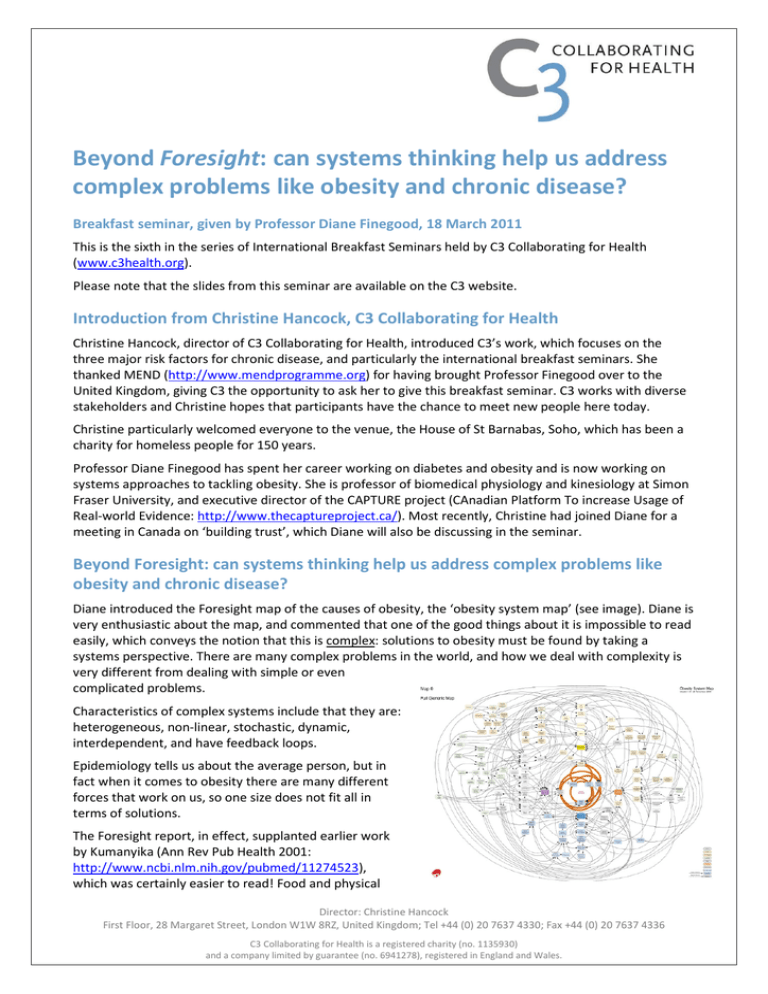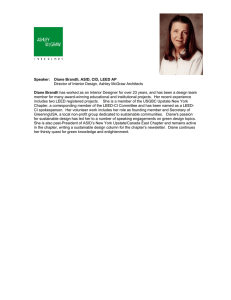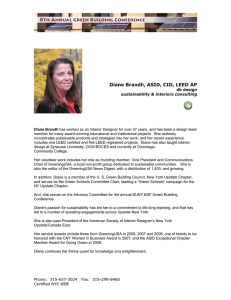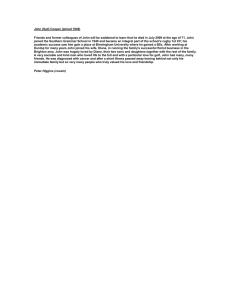Beyond Foresight: can systems thinking help us address
advertisement

Beyond Foresight: can systems thinking help us address complex problems like obesity and chronic disease? Breakfast seminar, given by Professor Diane Finegood, 18 March 2011 This is the sixth in the series of International Breakfast Seminars held by C3 Collaborating for Health (www.c3health.org). Please note that the slides from this seminar are available on the C3 website. Introduction from Christine Hancock, C3 Collaborating for Health Christine Hancock, director of C3 Collaborating for Health, introduced C3’s work, which focuses on the three major risk factors for chronic disease, and particularly the international breakfast seminars. She thanked MEND (http://www.mendprogramme.org) for having brought Professor Finegood over to the United Kingdom, giving C3 the opportunity to ask her to give this breakfast seminar. C3 works with diverse stakeholders and Christine hopes that participants have the chance to meet new people here today. Christine particularly welcomed everyone to the venue, the House of St Barnabas, Soho, which has been a charity for homeless people for 150 years. Professor Diane Finegood has spent her career working on diabetes and obesity and is now working on systems approaches to tackling obesity. She is professor of biomedical physiology and kinesiology at Simon Fraser University, and executive director of the CAPTURE project (CAnadian Platform To increase Usage of Real-world Evidence: http://www.thecaptureproject.ca/). Most recently, Christine had joined Diane for a meeting in Canada on ‘building trust’, which Diane will also be discussing in the seminar. Beyond Foresight: can systems thinking help us address complex problems like obesity and chronic disease? Diane introduced the Foresight map of the causes of obesity, the ‘obesity system map’ (see image). Diane is very enthusiastic about the map, and commented that one of the good things about it is impossible to read easily, which conveys the notion that this is complex: solutions to obesity must be found by taking a systems perspective. There are many complex problems in the world, and how we deal with complexity is very different from dealing with simple or even complicated problems. Characteristics of complex systems include that they are: heterogeneous, non-linear, stochastic, dynamic, interdependent, and have feedback loops. Epidemiology tells us about the average person, but in fact when it comes to obesity there are many different forces that work on us, so one size does not fit all in terms of solutions. The Foresight report, in effect, supplanted earlier work by Kumanyika (Ann Rev Pub Health 2001: http://www.ncbi.nlm.nih.gov/pubmed/11274523), which was certainly easier to read! Food and physical Director: Christine Hancock First Floor, 28 Margaret Street, London W1W 8RZ, United Kingdom; Tel +44 (0) 20 7637 4330; Fax +44 (0) 20 7637 4336 C3 Collaborating for Health is a registered charity (no. 1135930) and a company limited by guarantee (no. 6941278), registered in England and Wales. activity behaviours are central, but these are affected by a range of other relevant factors. There is a distinct difference between the Kumanyika work and Foresight – the earlier version appears very linear, with all the external forces acting on the individual in a single direction, i.e. it is presented as a complicated problem as opposed to a complex problem. The fact that you cannot see the individual trees in the forest of the Foresight diagram is an advantage. The common responses to complex problems are often, retreat, despair and believing the problem is beyond hope – and the original Foresight team were worried that they might engender this response. Other responses include the difficulty of ascertaining who is responsible, and the lack of simple solutions. But it is also an opportunity to galvanise collective efforts and invest significant resources. (Diane noted that Canada has a minority right-wing government that has not dealt with this issue, but an election is coming so this may change.) What are the implications of complexity? Establishing causality is difficult – there are over 100 variables in the Foresight map, for example, so working out the role of each interdependent variable is very artificial. A reductionist paradigm (causality) is not particularly helpful (scientists are generally not as amenable to this idea as the audience at the seminar!). An integrated paradigm – i.e. based in the real world – is important. So, where do we go now, given that we tend to look for solutions from isolating individual causes, which is not possible in this case? There are common aspects to complex problems: • Scale is important, and there are important interactions between different levels. • Individuals matter – not just the people who may be gaining weight, but also the individual stakeholders (such as the CEO of a food company). • Competition and cooperation are interdependent variables – to establish more cooperation across sectors, we need to think about how to set competition. Building trust is important here. Scale: relationship between the micro and the macro To demonstrate the relationship between the micro and the macro, Diane used an analogy with water. Molecules in water move randomly, but what you see at the macro level is a static glass of water. Similarly, when water flows, there is still random molecule movement, but all the molecules are also moving in the direction of the water flow, which can be very powerful and coherent. If all the molecules are totally aligned, you get ice. In tackling obesity and non-communicable diseases, there are many levels to consider (genes, through families and communities, up to international levels), and the interaction between these levels is important. To foster change at population level (the flowing water), you also need to think about lower levels (the individual molecules). The Foresight map is useful in that one can zoom in to look at the details of the variables, and zoom out to get a better picture of the whole. Diane showed a slide of the different clusters in the map (e.g. ‘individual psychology’ and ‘physical activity environment’), in which the thickness of the lines joining the variables was proportional to the number of underlying linkages between variables. For example, there is a very thick arrow from food production to food consumption – and there is no arrow back the other way. This suggests that food production is a primary driver of food consumption (at least for those who put together the map – which probably did not include the food industry). Diane noted, however, that there are, in reality, forces that work the other way (i.e. demand plays a role in what food is produced). 2 www.c3health.org The individual at the centre of the Foresight map is called the ‘engine’ – but this is somewhat misleading as individuals do not really drive this process, with many arrows coming in, but not out. Individuals can make changes, however. Donella Meadows worked on climate change in the 1990s and devised a 12-level intervention framework (Wikipedia reference: http://en.wikipedia.org/wiki/Twelve_leverage_points). Diane’s team has developed a five-stage framework for intervention from Meadows’ work: • The paradigm is our most deeply held beliefs – they are difficult to change, but when they do they are very effective. In the case of tobacco, for example, over the last 50 years smokers have gone from being cool to being pariahs. • • Goals – watch to see what the system is trying to achieve • • [For obesity] Paradigm: We need to shift to a complex systems approach and solutions appropriate for complex problems. [For obesity] Goals need to include increasing physical activity, improve diet habits and the quality of the food supply. Structure – this is about the system as a whole, e.g. connectivity and trust. • [For obesity] Structural changes needed include increasing the coherence (not alignment) in the clusters of the Foresight map – i.e. all pull in the same direction, but use diversity for problem solving (i.e. you do not want a totally static approach; ice in the H2O analogy above); also, trust is important. Feedback and delays – this is about reinforcing and balancing loops • • [For obesity] Feedback and delays: There are more than 100 feedback loops in the Foresight map – some are positively reinforcing, others are balancing/negative (i.e. as A goes up, B goes up, which makes A go down). We need to shift the dominance of feedback loops from the current majority of reinforcing loops to more balancing loops. Structural elements are the individual variables, actors and subsystems • [For obesity] Structural elements are the things we tend to think about regularly – physical education, marketing, affordable food etc. Currently, most of the evidence is at the level of the structural elements rather than, for example, at the level of feedback loops, as has been demonstrated by Diane and colleagues, who have mapped the distribution of recommendations to address obesity and chronic disease on to the five levels. So, where is best to invest for optimal effect? Where should the effort go? Diane contends that there is a gap in the feedback and delays area. Diane illustrates this with the ‘parents’ jury’ idea. Rather than pushing the government to change marketing to children, a group of parents created their own feedback loop by getting other parents to vote on the most offensive marketing, the results of which they then took straight to the media – and advertisements have been taken off television in response, for example. One of Diane’s students is currently collecting examples of feedback loops and typologies, to help people to work out how best to use them. Individuals matter In such a large system, it is counterintuitive that individuals could matter – but they do. An essential point here is the need to match the capacity of individuals to do their individual tasks with the complexity of the task. We are not all equal in our capabilities. The key is that if my tasks are more complex than my capacity, then I will fail. For example, the CEOs of food companies have to balance customers, employees, shareholders and others, which can be very difficult. Diane said she has struggled with overweight herself for her whole life, and has to deal with the complexity of her own environment. 3 www.c3health.org If we are failing, we need either to increase our capacity or to decrease the complexity of our environment. Education is probably not particularly effective – so is the solution to increase capability or decrease the complexity of the environment? When we are overwhelmed by the complexity of the environment, if the government does not help then we are likely to ignore the problem entirely. The messaging in the food environment is hugely complex, and often inconsistent and overwhelming. You need to be a dietician to understand most of the nutrition facts on some food labels – and not only that, but serving sizes vary and in Canada you have to do maths even just to work out the calories in the pack. There are multiple food and nutrition sources beyond pack labelling (although labelling is the most frequently used) – including friends, magazines, TV. The most credible sources (such as the government and dieticians) other than labelling tend to be the least used. In the face of too much information, most of us just eat mindlessly. According to Brian Wansink, author of Mindless Eating, the average person makes 250 decisions every day about food, the vast majority of which are mindless because this is the only way we can cope with the number of decisions – for example, whether or not to eat breakfast; whether to eat toast or fruit; whether to eat in the kitchen or on the train, etc. (see http://www.mindlesseating.org/). So, the principle that complexity matches capacity is important – and can be a source of solutions, or at least a litmus test for solutions. For example, we do not want a nanny state – but how about the government requiring a single labelling system? Diane thinks a more sensible system of labelling has been developed by David Katz (although unfortunately it is a proprietary system: http://www.nuval.com/), which gives each food a single number combining nutrient and caloric information. This reduces complexity – but the system must be worked out very carefully, of course. Competition and cooperation Combining cooperation and competition is very important: in sport, to be the most successful and competitive in the league, the team must have the most cooperative and collaborative individuals on their team. Diane showed a version of Foresight (by B. Butland, unpublished) showing the government departments responsible for each part of the Foresight map (though without the departments labelled). The departments need to cooperate to make a difference. ActNowBC’s Promising Practices programme put together a strategy to increase collaborative action. It created an incentive fund ($15 million) that required ministries other than the ministry of health to compete for the funding to tackle obesity. Provided that the competition is set at the right level (e.g. competing for funds) then the collaboration that you need will follow (e.g. ministries learning from each other). Trust as a system variable Competition is not always desirable, however, and Diane sees trust as a system variable, one that is relevant across the board. Trust decreases complexity – a high-trust society is much easier to live in, whereas low-trust societies can be economically disastrous. Diane recommended that the conversation no longer be polarised in silos, particularly around food: building trust across sectors is essential. The organisations that have supported the ‘Building Trust’ meetings she has held, and that are happy for their logos to be included, have included McDonald’s, Health Canada, civil society organisations, both Coca-Cola and PepsiCo, and many others – the only organisation that did not want its logo associated with the work was in government! Lessons learned through the Building Trust initiative: • 4 Building trust within a sector is harder than between sectors – this is perhaps not surprising, as food companies compete, academics compete for funding, NGOs compete for donor money, etc. www.c3health.org • Regulation is needed when you do not want businesses in an industry to compete with each other. Salt, for example, makes food taste good, and most companies know how much they can reduce sodium before consumers stop buying the products. As tastes change only slowly, this is a problem – unless sodium is reduced across the board then it is hard for one company to trail-blaze, as they will lose consumers. Only if people buy a product because it is ‘healthy’ rather than it ‘tastes good’ will companies change – unless they are made to do it. A number of companies are making the changes to healthy but not telling us, because there is less risk in not telling us than in telling us! • Trust-building needs a safe space. At the second meeting of the group it became clear that brand association can be a problem – for example, Coca-Cola had the rights to the 2010 Torch Relay and partnered with Participaction (http://www.participaction.com), an NGO, in engaging children in being active. Participaction was criticised for associating its brand with Coca-Cola – but maybe Coke just wanted to do the right thing! It can be very hard to build relationships. Building Trust video This video presented some extracts from interviews from a number of participants in the Building Trust initiative, including: • There is ‘cordial hypocrisy’ in all sectors – everyone talks about being part of the solution, but the reality is that they often do not talk, and merely level accusations at each other. • A woman from the Ronald McDonald Foundation said that a few years ago she had very quickly felt uncomfortable in an early meeting on childhood obesity. • What is particularly hard is that sometimes the criticisms are misunderstood – there need to be forums where these issues can be better understood. • The meeting is about finding ways to move forward – having conversations and finding the overlaps in approach allow the bar to be moved. • Health promotion principles at the level of population health have to be achieved inter-sectorally. • Obesity as a problem is complex; working cross-sector is complex – but it is all much easier where there is trust. Building an emotional response is important. • Every action has consequences, so each sector can share what differences and challenges they face. • The discussions channelled tension and informed participants’ thinking, and took the participants beyond traditional barriers to a place where better solutions will be found – somewhere where we have a responsibility to go. Discussion Pam Garside, C3 board member • What is Diane’s opinion of ‘nudge’? • Understanding behavioural economics is very important, although Nudge did not do a good job of phraseology. The basic idea – what drives behaviour – is really important. Organ donorship, for example, goes up from about 30% to nearly 100% when it is opt-out rather than opt-in (this is an example of reducing complexity through a nudge). Steve Cummins, Queen Mary, University of London • His first question related to scientific thinking: When you take action on one part of the system, there may be unintended consequences of an action on another part of the system, so how do you work around this? Most complex systems have porous borders – it is not a closed system (i.e. other things are in play beyond the map). Unintended consequences are very hard to identify, yes, and a reductionist approach will not get us there. But the more integrated we are in our thinking, the better chance we have of identifying these unintended consequences. 5 www.c3health.org • His second question related to policy: In the UK at the moment, capacity investment is decreasing (e.g. tuition fees, local authority cuts). How can this fit with systems thinking? • If we decrease capacity, we will have to decrease complexity (i.e. more nudging or even ‘nanny state’-ing); without this, there will be more failure. Conceptually, this makes sense – but politicians will not do this! Barbara Gallani, Food & Drink Federation • How do you move to putting all this into practice, given the short timescales etc.? • Diane talked about the CAnadian Platform To increase Usage of Real-world Evidence (CAPTURE) project. We are generally very bad at using and evaluating evidence of projects – for example, there are no common indicators across initiatives and environments – so CAPTURE is building a web-based platform to help collect and share evaluative information. One problem is that much of the evaluation is done professionally (with the evaluators dropping in, doing the evaluation, and leaving a report – rather than building capacity). Until we build common tools and collect the information in a single place, we will struggle with this. • Once we have the tools, we need to change the culture. Practitioners do not want the academic info: they want to know what other individuals have done, and how projects can be adapted for their own communities. Geraint Lewis, Nuffield Trust • Geraint mentioned the new Responsibility Deal in England. The tobacco companies are excluded from all discussions, but there is a Responsibility Deal on alcohol – what are Diane’s thoughts on this, particularly with regard to the NGO groups that recently pulled out? • Lack of trust cannot have helped – but is it that there is a lack of trust among the public (i.e. because the ‘environment’ isn’t conducive to trust, which would be unfortunate), or because the people across the table (i.e. people from the alcohol companies) are not trusted? It takes a long time to build trust. The last Building Trust meeting had an interesting discussion on pester power and parental responsibility, for example. • The climate for a conversation with tobacco is so charged, it would be very hard to have a discussion. The difference between tobacco and food is that we do need food. Jack Winkler, Nutrition Policy Unit • There are two major extraneous (i.e. outside-the-map) variables: climate change and the financial crisis, which is initiating a rise in commodity prices. The price of food affects the amount we eat, and to think systematically about obesity requires thinking about both of these issues. • When Diane is not feeling optimistic, she wonders why she spends so much time thinking about obesity because in a few years it will solve itself, but not in a good way (namely through peak oil, lack of water and food etc.). • The impact of the financial crisis may be to push us towards cheaper food – which may be the least nourishing. • In Cuba, when the country was blockaded and food and petrol were in short supply, physical activity went up, calories decreased and obesity fell, and NCDs fell. • On the other hand, Tom Robinson and others say we should work with those fighting climate change, because they are similar society-wide problems. David Buck, King’s Fund • David felt that Diane’s comments favoured regulation, and drew participants’ attention to the Nuffield ‘ladder of interventions’, which goes from nudging to regulation. He particularly commented that it is interesting that in some cases industry would like regulation. There may be tipping points for industry – 6 www.c3health.org i.e. either no one goes in or we all go in – so maybe the government would be willing to regulate in some areas. • He also commented that industry and government are quite good at putting bits of money into feedback loops to have an impact. • Diane was not sure that this is the case, however – and we certainly need to know how to make much better use of feedback loops: just putting in money will not necessarily create a feedback loop. A may increase B and B increase C – but either B or C must feed back into A for it to be a genuine feedback loop. We need to think harder about how to achieve this. Christine Hancock • 7 Christine thanked Diane for the seminar and encouraged everyone to talk to her and each other over coffee. www.c3health.org




